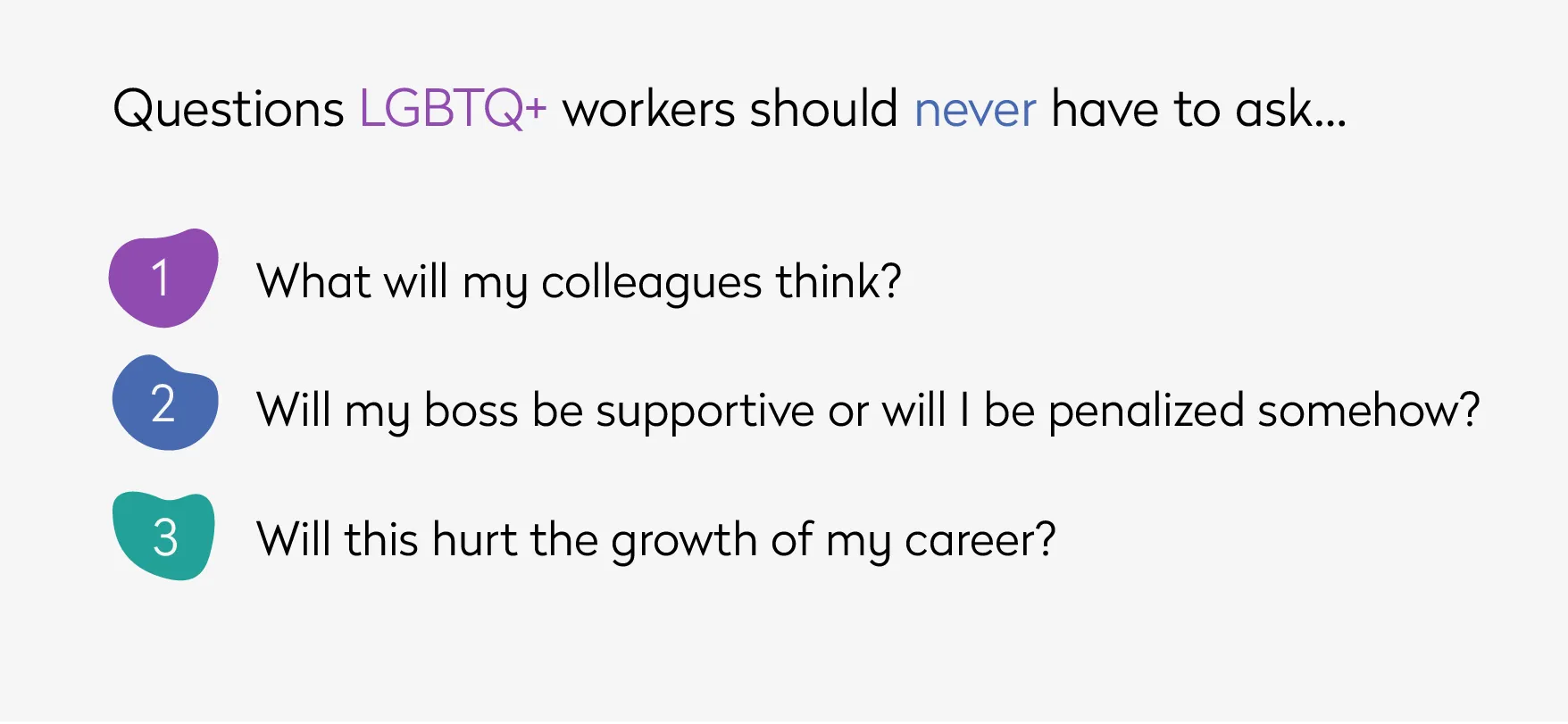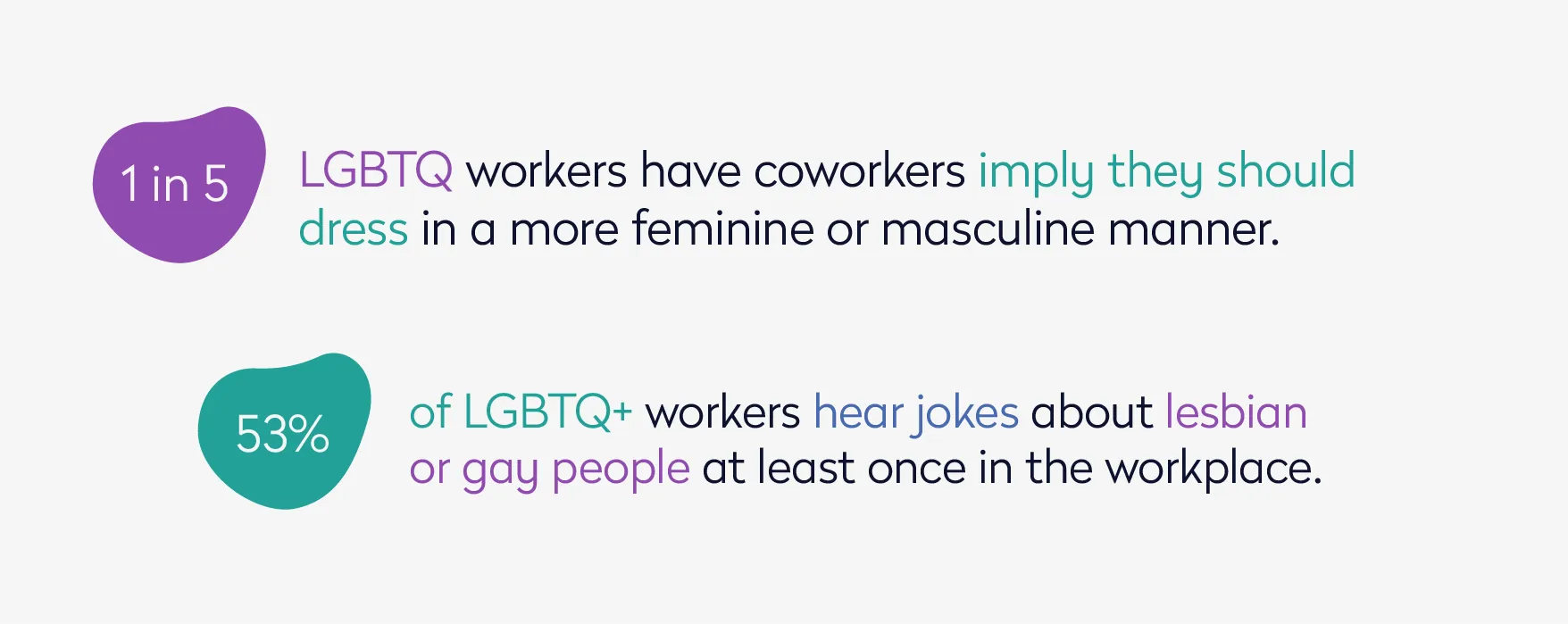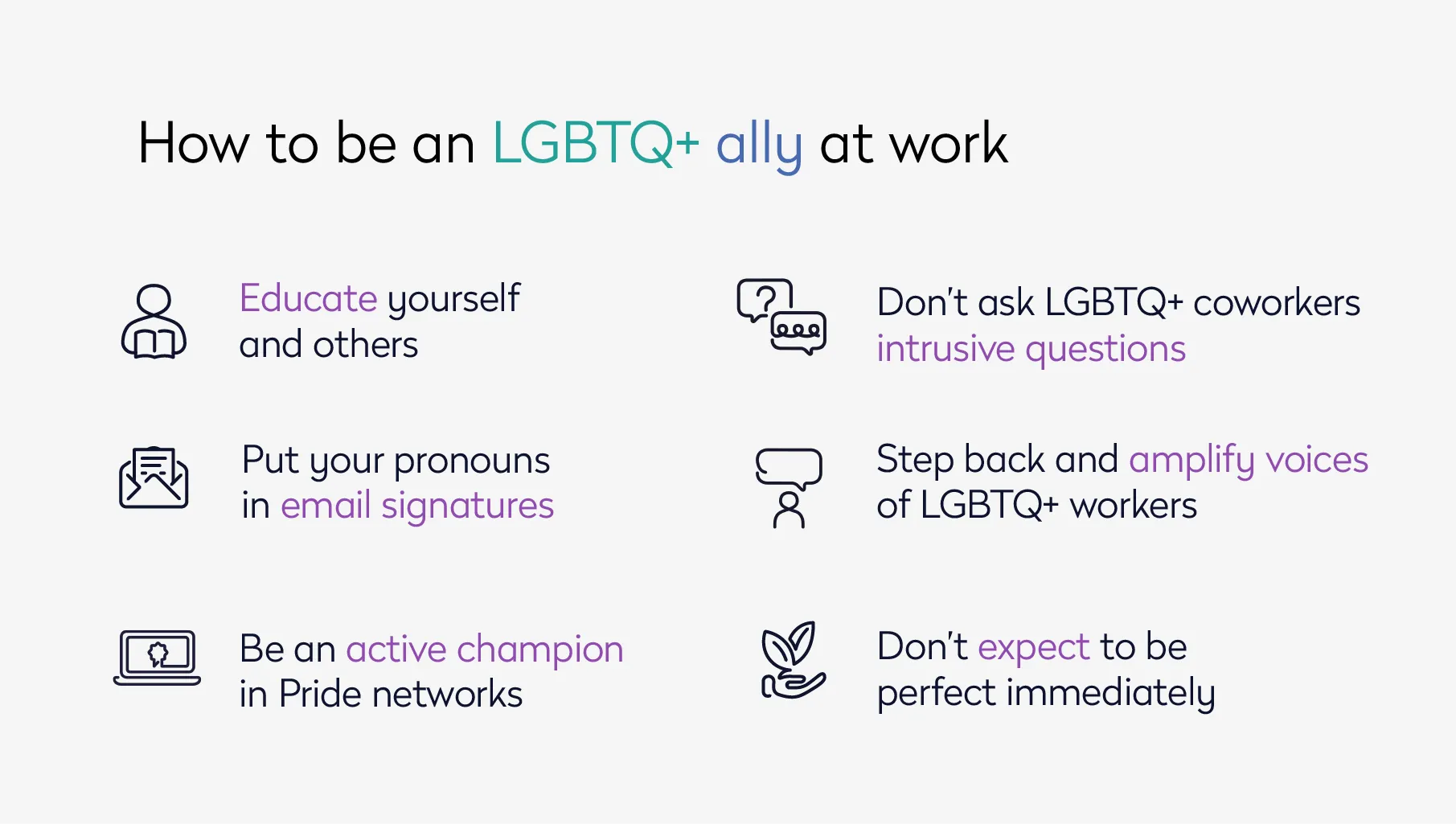
Corporate support has played a crucial role in the progress of LGBTQ+ (lesbian, gay, bisexual, transgender, and queer) rights over the past two decades. Specifically, more companies celebrate Pride Month as a public gesture of support every June.
With that said, some members of the LGBTQ+ community still struggle with feeling accepted in their place of work. Leaders must address the underlying issues, such as fear and bullying, lack of social acceptance, and a need for visible allyship and DE&I policies.
People spend the majority of their time working. Pride matters not only in our personal lives, but also professional.
Why we celebrate Pride month in the workplace
Today, Pride Month is exceptionally well known. But what many people don’t know is what inspired the thirty-day-long celebration. Turn the clock backward to learn how Pride and the LGBTQ+ community weren’t always celebrated but instead actively targeted.

In the 1960s, police standard practice was to raid clubs known for catering to gay patrons. These brutal raids often resulted in beatings, injuries, and jail. And ultimately, they led to a terrible incident on June 28, 1969, known as the Stonewall Uprising.
That night, police targeted the Stonewall Inn in New York City, and something unexpected happened. When authorities got violent, protestors fought back. It was the beginning of spontaneous protests and demonstrations that made public the need for the entire LGBTQ+ community to be able to live freely and be accepted.
The following year, the group established the first organized LGBTQ+ rights parade. Since then, the movement has continued to grow and gain support.
So, why does this matter for businesses?
Pride Month is about basic fundamental human rights. LGBTQ+ employees often face hostility, and it’s up to companies to provide a safe space at work. While leaders can’t control what happens to their employees outside of work, they can regulate what happens during work hours.
Celebrating Pride Month in the workplace reinforces to your employees that they are always accepted for who they are, no matter who they love or how they identify. Doing so promotes awareness and equality within the company and increases understanding of the issues faced by those in the LGBTQ+ community.
Eliminate fear and bullying in the workplace
In the UK, the Equality Act 2010 came into force to protect people from discrimination in the workplace, with sexual orientation and gender identity (SOGI) discrimination listed as protected characteristics. In 2021, the US provided similar protection with The Equality Act, officially ensuring that companies cannot discriminate against individuals because of their SOGI.
Both forbid sexual orientation and gender identity discrimination in any aspect of employment, including hiring, firing, pay, job assignments, promotions, layoff, training, fringe benefits, and any other term or condition of employment. While these government acts are groundbreaking, many LGBTQ+ employees still fear being ‘out’ at work.
Why?
Nothing changes overnight. After a law or act is put in place, it often takes time for everyone to catch up. In the UK, 21% of LGBTQ+ professionals reported workplace discrimination and bullying. Similarly, in the US, 36% of LGBTQ+ employees said they had experienced the same issues.

Four out of every 10 LGBTQ+ employees experience bullying toward their personal attributes, such as appearance or gender. And 47% are the subject of gossip among their co-workers and sometimes even leaders. Unfortunately, the negative impact isn’t only emotional. One out of 5 LGBTQ+ workers mistreated results in health-related problems, with 15% saying they called out of work due to bullying.
Despite this behavior being illegal, many LGBTQ+ members stay silent, fearing that speaking up will only penalize them further. A company’s job is to show its support proactively and visibly to the community. Pride Month is an excellent time for you – as a business – to promote acceptance in the workplace by publicizing LGBTQ+ policies, hosting anti-discrimination workshops, and using content channels to bring awareness to diversity, equity, and inclusion (DE&I).
Lastly, you can reiterate that harassment against SOGI will not be tolerated and encourage employees to speak up if they experience it personally or witness it first-hand.
Promote social acceptance among employees
Social acceptance refers to an individual’s formal or informal admission into a group. For the LGBTQ+ community, it means having society positively support their sexual orientation and gender identity.
Companies have the power to create workplace climates that welcome the LGBTQ+ group. A recent HRC Foundation report found 46% of LGBTQ+ employees in the US remain closeted at work, suggesting organizations have room for improvement.

So, how can businesses promote social acceptance for the LGBTQ+ community during Pride month?
- Create educational opportunities for your employees regarding the importance of Pride and the LGBTQ+ rights movement
- Update your company email signatures to allow your employees to add their pronouns
- Provide your employees with a Teams or Zoom background that celebrates Pride month
- Incentivize your employees to take part in Pride celebrations
- Change your logo on social media to represent Pride in June
- Hire LGBTQ+ leaders throughout your organization
Sadly, society doesn’t make it easy to go against what is deemed the majority. But social acceptance helps change this narrative by advocating that our differences actually strengthen us as a whole.
Ultimately, the goal of promoting acceptance of LGBTQ+ rights among employees is for those within the community to feel more comfortable being their authentic selves without fear. Jason Collins was the first athlete in the NBA to openly come out as gay, hoping to bring more acceptance to other LGBTQ+ people. He expressed, “Openness may not completely disarm prejudice, but it’s a good place to start.”
There is no denying it, LGBTQ+ employees who live as their most genuine selves in the workplace are brave. That said, bravery is the suppression or masking of fear. Organizations must do their best to ensure their LGBQT+ workers don’t feel afraid in the first place.
Show support and allyship of the community
Struggling with our identities isn’t limited to our younger, formative years. Being comfortable with who we are and who we love comes at any age. Corporate support of the LGBTQ+ community encourages a safe space at work. But expressing support isn’t enough; you must position your business as an ally.
Create an LGBQT+ Allyship Pledge and make it accessible to employees and customers. This pledge aims to create a sense of belonging for workers that goes above and beyond the law and company policies.
But allyship is more than publicly announcing you support the community; it’s about aligning your behaviors with those words. A company’s actions must demonstrate that they accept and validate LGBTQ+ individuals entirely.
Let’s look at the four pillars of an LGBTQ+ Allyship Pledge and how a company can support them with action:
- Visibility
Raise awareness and understanding of LGBTQ+ rights in the workplace.
Action: Include an overview of LGBQT+ workplace protections within new employee orientation, the employee handbook, and your website. - Adaptability
Educate employees on LGBTQ+ issues in the workplace.
Action: Host webinars that appropriately discuss LGBTQ+ issues in the workplace by addressing evolving issues within the community and the health-related effects of SOGI discrimination. - Communication
Ensure corporate language is welcoming for LGBQT+ employees.
Action: Encourage the company-wide usage of terms that are respectful and consistent with every employee’s self-understanding, including using proper pronouns. When collecting any demographic information – such as employee engagement surveys – ensure there are opportunities for people to identify as LGBTQ+. - Accountability
Be intolerant of LGBTQ+ harassment or discrimination in the workplace.
Action: Provide a list of Speak Up resources – an easy and effective way for employees to report concerns – that are available to anyone who has witnessed this harassment or has been subject to it themselves. For example, provide specific emails and phone numbers to your Human Resources (HR) and Diversity, Equity, and Inclusion (DE&I) departments. Lastly, provide information for your Helpline service if you have one in place.
The old saying remains true; actions speak louder than words. Showing support and allyship in the workplace works to prevent LGBTQ+ employees from experiencing prejudice. An LGBTQ+ Allyship Pledge is promising, but your actions set the tone for the culture.
Remind your workforce diversity and inclusion are a priority
Pride Month reminds us that diversity is more than just what we can see. As discussed, some LGBTQ+ employees don’t feel comfortable coming out at work. After witnessing their LGBQT+ colleagues targeted, they worry their careers and mental health could suffer if their SOGI status is revealed.

Remind your workforce that diversity and inclusion are a priority for your organization. Remember, hiring a diverse workplace doesn’t make a difference without then allowing diversity to flourish. By fostering inclusivity, you enable your teams to contribute their all.
Diversity and inclusion go hand in hand.
Metaphorically speaking, diversity is being invited to the party and inclusion is being asked to dance. The two together allow employees to feel safe to be their best and most authentic selves. Employees will disengage and leave even the most diverse company if they don’t feel genuinely included and accepted.
The unconscious biases and ingrained systems toward the LGBTQ+ community can hinder businesses from getting and retaining the best workforce. From the top down, foster an inclusive environment. Diversity of opinion and thought won’t matter if diverse perspectives – in this case, LGBQT+ employees – are not encouraged.
While this takes year-round effort, Pride Month is an auspicious time to bring awareness to your company’s efforts toward diversity and inclusion.
Continue to show your Pride all year long
Pride may only be in the month of June, but you can look at the world through rainbow-colored glasses no matter the month. The end of June doesn’t mean the end of Pride. LGBTQ+ bias occurs daily, so companies must fight SOGI-based discrimination beyond Pride.

While LGBTQ+ allyship may be more visible in June, strive to be an ally to the community all year round and encourage your workers to do the same.


